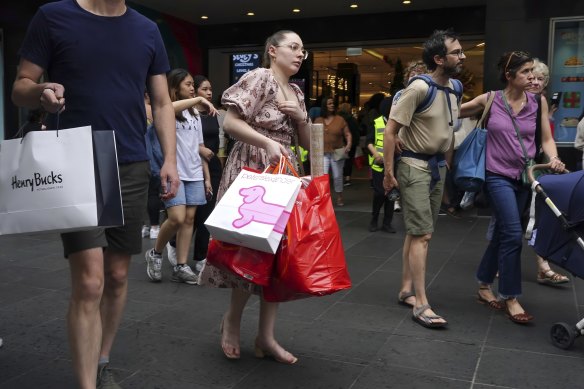By Rachel Clun and Shane Wright
An early start to end-of-financial-year sales and shoppers keen for a bargain boosted retail turnover in May, but ongoing cost-of-living pressures mean retail spending remains weak.
Retail turnover rose by 0.6 per cent in May following two sluggish months of consumer spending, according to figures that the central bank will closely monitor before its next board meeting in early August.

Retail spending rose in May thanks to early end-of-financial-year sales.Credit: Luis Enrique Ascui
Retail turnover in clothing, footwear and personal accessories led the increase, according to Australian Bureau of Statistics data, rising by 1.6 per cent in May after falling for two consecutive months.
Household goods spending also rose 1.1 per cent, but spending at department stores fell 0.9 per cent and spending on cafes, restaurants and takeaway fell 0.1 per cent.
ABS head of business statistics Robert Ewing said retail businesses were relying on discounting and sales to stimulate non-essential spending.
“Many retailers started end-of-financial year sales early, offering larger discounts than usual and noted that shoppers remain price-sensitive in response to persistent cost-of-living pressures,” Ewing said.
Moody’s Analytics economist Sunny Nguyen said many of the sales started in May would continue through to July, as tax returns, the stage 3 tax cuts and the increase to minimum wages would boost real incomes.
“That said, whether all that extra income will translate into extra spending is uncertain,” Nguyen said, pointing out that unemployment was rising, inflation remained high at 4 per cent and there was uncertainty about when the Reserve Bank would start cutting interest rates.
“All that may nudge consumers to save rather than spend any additional income.”
Over the longer term, retail spending remains weak, increasing by 1.7 per cent since May last year. In the year to May, spending on clothing, shoes and accessories was down 0.2 per cent and department store spending was down 1.7 per cent.
Australian Retailers Association chief industry affairs officer Fleur Brown said the ongoing decline in discretionary spending showed consumers remained under financial pressure.
“Other retailing is the only standout performer in May, and that’s typically because beauty products are the last category to be affected by economic downturns,” she said.
Brown said the sector was under immense pressure from ongoing labour and supply shortages and a wave of retail crime, as well as slower consumer spending.
“The ongoing cost-of-living pressures, interest rate ramifications and increased cost of doing business make it a challenging period – particularly for those in the discretionary retail sector and small to medium-size businesses.”
CreditorWatch chief economist Anneke Thompson said the retail sector overall would see mixed results in insolvencies from here.
“Retailers that offer budget options and sell non-discretionary items will fare much better than retailers that sell discretionary items,” she said.
“Despite the small rise in household goods retailing, the slowdown in home completions coupled with the huge amount of pulled-forward spending during COVID lockdowns will result in less demand in this sector.”
Cut through the noise of federal politics with news, views and expert analysis. Subscribers can sign up to our weekly Inside Politics newsletter.